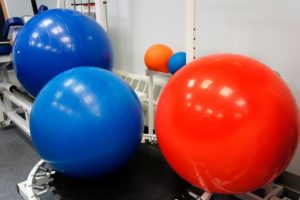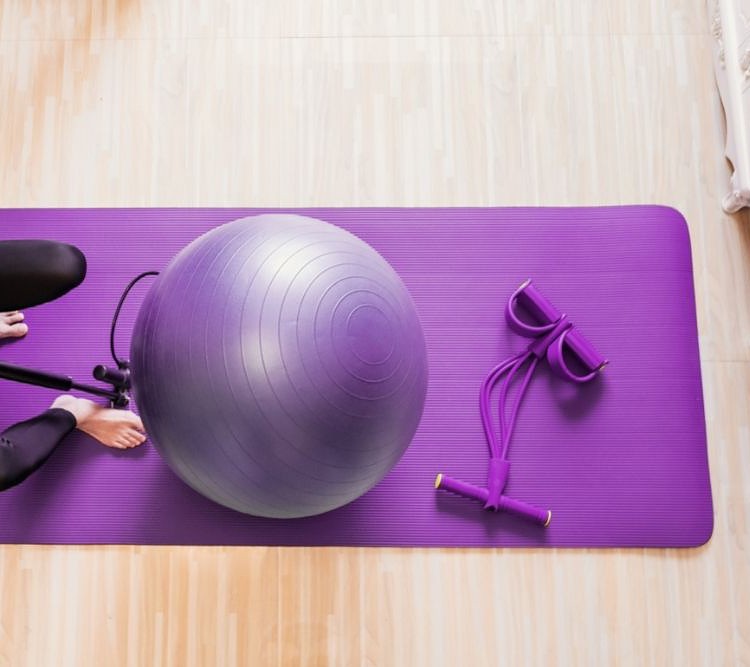We like to have all the necessary tools before starting a project. Inflating an exercise ball is no different.
You will need five items to inflate your exercise ball: the pump, air nozzles, hose, plug, and measuring tape. Most new exercise balls are packaged with most of these items. If your exercise ball is older or you do not have these tools, then you can purchase them in stores or online. If you need help with inflating your exercise ball and when to tell when it is inflated properly, then keep reading to find out more.
Table of Contents
What Do You Need to Inflate an Exercise Ball?

You will need an air pump, nozzle attachments, hose, exercise ball plug, and measuring tape. Exercise balls do not come prepackaged with measuring tapes, so that is a tool you will need to supply yourself.
For air pumps , you can use a manual hand pump, usually, the one included with your exercise ball, or you can use an electric air pump. The electric air pump will fill your exercise ball faster and easier for you, though you will need to closely monitor your ball to make sure it does not overfill.
The nozzle that attaches to the hand or electric pump should be made of plastic and narrow enough to squeeze into the hole on the ball. Most manufacturers use a plastic nozzle because they are safer for the soft and stretchy exterior on exercise balls.
An air hose that comes with an exercise ball is normally made of plastic and has an accordion appearance. If you are using a hand pump, then you will need a plastic air hose. Make sure the hose has a tight seal to prevent any air from leaking out.
Ball plugs are normally long thin white plastic pieces with a flat head at the top. Not all exercise balls come prepackaged with ball plugs. However, some come with one or two ball plugs and plug removers.
If it is the first time filling your exercise ball, then you may not need to use a plug remover. Sometimes manufacturers will send your new exercise ball with a plug already in it, requiring you to remove the plug from the exercise ball using the plug remover.
You can easily purchase a ball plug and plug remover kit online if it does not come packaged with your exercise ball.
How to Inflate an Exercise Ball?

Inflating an exercise ball is simple. Once you have collected the items we listed above, you will be ready to inflate your exercise ball.
Step 1 – First, you must assemble the pump by connecting the hose to the air pump.
Every hand pump is made a little different and some hoses are already attached to the air pump. If this is the case, move on to step two.
Step 2 – If the ball plug is already inserted into the ball, then you will have to remove it using plug removers or your fingers.
Step 3 – Choose the air nozzle that fits best into the ball and connect it to the hand pump. Insert the nozzle into the ball.
Step 4 – Begin pumping your exercise ball with air by squeezing or pressing on the hand pump.
Filling an exercise ball for the first time can take 10 to 20 minutes. For some, this is an exercise in itself. Feel free to move the pump from your hand to your foot to give your muscles a break.
Step 5 – Once the ball is filled to its proper capacity according to its size, remove the hose and air nozzle and push the plug into the ball. The plug should sit inside the hole with a firm grip.
For a visual representation of this process, check out this step-by-step YouTube video of how to inflate an exercise ball.
How Do You Know if Your Exercise Ball is Inflated Enough?

Your exercise ball is inflated enough when it no longer feels squishy or soggy. Also, It should not be so tight that when you sit on it, the exercise ball doesn’t decompress a few inches.
We’ve seen a trick on how to make sure a ball is inflated enough. For this “trick,” you will need a tape measure, a wall, and a box or item of some sort as a marker.
From there, you will measure from the wall outwards the size of your exercise ball. So if you bought a 65 cm diameter exercise ball, you would stretch the tape to measure 65 centimeters from the wall.
Keep your extended tape measure on the floor and place the box or other pace marker item on the opposite end of the tape measure. The length of the tape measure will be the width of your exercise ball once you fill it with air.
Pump air into your exercise ball until the ball touches both the wall and the box on the other side. Once both sides touch, your exercise ball is inflated enough.
FAQs:
Can you Use a Bike Pump or an Air Compressor to Inflate an Exercise Ball?
Yes, you can use a bike pump or air compressor to inflate an exercise ball. As long as it has a narrow enough nozzle attachment to fit into the hole on your ball, there is nothing wrong with using these types of air pumps.

Can you Inflate an Exercise Ball at a Gas Station?
Yes, you can inflate an exercise ball at a gas station. Make sure the nozzle is thin enough to fit into the ball or wide enough to fit snuggly.
Since gas station air pumps are electric, you will need to closely monitor the air building inside your exercise ball to prevent it from bursting or overfilling.

Can you Inflate an Exercise Ball with a Straw?
Yes, you can inflate an exercise ball using a straw. With that said, it is not a recommended method to fill an exercise ball because it would take you hours to fill.
Unlike a flat soccer ball or basketball, an exercise ball can hold a lot more air inside of it. If you want to save yourself time, inflating an exercise ball with a straw is not the quickest way.
Conclusion

With an air pump, narrow nozzle attachment, hose, ball plug, and measuring tape, you will have everything you need to inflate an exercise ball. The steps above walk you through how to inflate an exercise ball.
Our instructions help you inflate your exercise ball to the correct width, so you do not risk underfilling or overfilling your exercise ball. If you don’t mind the wait, feel free to fill your exercise ball using a hand pump, bike pump, air compressor, gas station compressor, and even a straw.

My name is Vance, and I am the owner of To Ergonomics. Our mission is to improve your workflow by helping you create a supportive and welcoming environment. We hope that you’ll find what you’re looking for while you’re here.

